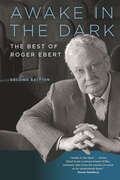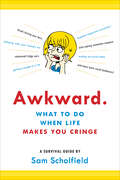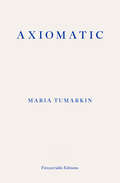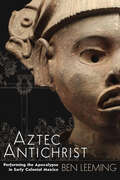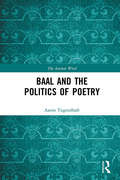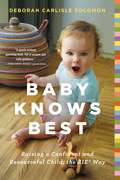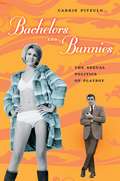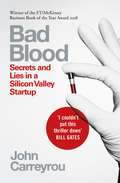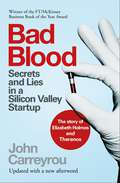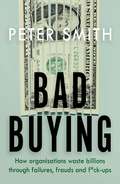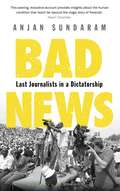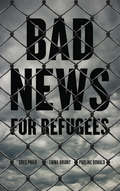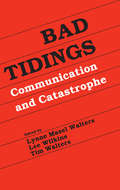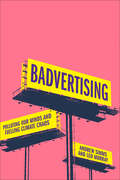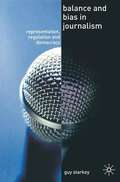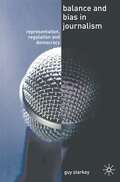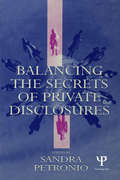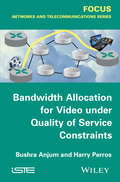- Table View
- List View
Awake in the Dark: The Best of Roger Ebert: Second Edition
by Roger EbertFor nearly half a century, Roger Ebert’s wide knowledge, keen judgment, prodigious energy, and sharp sense of humor made him America’s most renowned and beloved film critic. From Ebert’s Pulitzer Prize to his star on the Hollywood Walk of Fame, from his astonishing output of daily reviews to his pioneering work on television with Gene Siskel, his was a career in cinema criticism without peer. Arriving fifty years after Ebert published his first film review in 1967, this second edition of Awake in the Dark collects Ebert’s essential writings into a single, irresistible volume. Featuring new Top Ten Lists and reviews of the years’ finest films through 2012, this edition allows both fans and film buffs to bask in the best of an extraordinary lifetime’s work. Including reviews from The Godfather to GoodFellas and interviews with everyone from Martin Scorsese to Meryl Streep, as well as showcasing some of Ebert’s most admired essays—among them a moving appreciation of John Cassavetes and a loving tribute to the virtues of black-and-white films—Ebert’s Awake in the Dark is a treasure trove not just for fans of this era-defining critic, but for anyone desiring a compulsively readable chronicle of the silver screen. Stretching from the dramatic rise of rebel Hollywood and the heyday of the auteur to the triumph of blockbuster films such as Star Wars and Raiders of the Lost Ark, to the indie revolution that is still with us today, Awake in the Dark reveals a writer whose exceptional intelligence and daily bursts of insight and enthusiasm helped shape the way we think about the movies. But more than this, Awake in the Dark is a celebration of Ebert’s inimitable voice—a voice still cherished and missed.
Awake in the Dark: The Best of Roger Ebert: Second Edition
by Roger EbertFor nearly half a century, Roger Ebert’s wide knowledge, keen judgment, prodigious energy, and sharp sense of humor made him America’s most renowned and beloved film critic. From Ebert’s Pulitzer Prize to his star on the Hollywood Walk of Fame, from his astonishing output of daily reviews to his pioneering work on television with Gene Siskel, his was a career in cinema criticism without peer. Arriving fifty years after Ebert published his first film review in 1967, this second edition of Awake in the Dark collects Ebert’s essential writings into a single, irresistible volume. Featuring new Top Ten Lists and reviews of the years’ finest films through 2012, this edition allows both fans and film buffs to bask in the best of an extraordinary lifetime’s work. Including reviews from The Godfather to GoodFellas and interviews with everyone from Martin Scorsese to Meryl Streep, as well as showcasing some of Ebert’s most admired essays—among them a moving appreciation of John Cassavetes and a loving tribute to the virtues of black-and-white films—Ebert’s Awake in the Dark is a treasure trove not just for fans of this era-defining critic, but for anyone desiring a compulsively readable chronicle of the silver screen. Stretching from the dramatic rise of rebel Hollywood and the heyday of the auteur to the triumph of blockbuster films such as Star Wars and Raiders of the Lost Ark, to the indie revolution that is still with us today, Awake in the Dark reveals a writer whose exceptional intelligence and daily bursts of insight and enthusiasm helped shape the way we think about the movies. But more than this, Awake in the Dark is a celebration of Ebert’s inimitable voice—a voice still cherished and missed.
Awake in the Dark: The Best of Roger Ebert: Second Edition
by Roger EbertFor nearly half a century, Roger Ebert’s wide knowledge, keen judgment, prodigious energy, and sharp sense of humor made him America’s most renowned and beloved film critic. From Ebert’s Pulitzer Prize to his star on the Hollywood Walk of Fame, from his astonishing output of daily reviews to his pioneering work on television with Gene Siskel, his was a career in cinema criticism without peer. Arriving fifty years after Ebert published his first film review in 1967, this second edition of Awake in the Dark collects Ebert’s essential writings into a single, irresistible volume. Featuring new Top Ten Lists and reviews of the years’ finest films through 2012, this edition allows both fans and film buffs to bask in the best of an extraordinary lifetime’s work. Including reviews from The Godfather to GoodFellas and interviews with everyone from Martin Scorsese to Meryl Streep, as well as showcasing some of Ebert’s most admired essays—among them a moving appreciation of John Cassavetes and a loving tribute to the virtues of black-and-white films—Ebert’s Awake in the Dark is a treasure trove not just for fans of this era-defining critic, but for anyone desiring a compulsively readable chronicle of the silver screen. Stretching from the dramatic rise of rebel Hollywood and the heyday of the auteur to the triumph of blockbuster films such as Star Wars and Raiders of the Lost Ark, to the indie revolution that is still with us today, Awake in the Dark reveals a writer whose exceptional intelligence and daily bursts of insight and enthusiasm helped shape the way we think about the movies. But more than this, Awake in the Dark is a celebration of Ebert’s inimitable voice—a voice still cherished and missed.
Awake in the Dark: The Best of Roger Ebert: Second Edition
by Roger EbertFor nearly half a century, Roger Ebert’s wide knowledge, keen judgment, prodigious energy, and sharp sense of humor made him America’s most renowned and beloved film critic. From Ebert’s Pulitzer Prize to his star on the Hollywood Walk of Fame, from his astonishing output of daily reviews to his pioneering work on television with Gene Siskel, his was a career in cinema criticism without peer. Arriving fifty years after Ebert published his first film review in 1967, this second edition of Awake in the Dark collects Ebert’s essential writings into a single, irresistible volume. Featuring new Top Ten Lists and reviews of the years’ finest films through 2012, this edition allows both fans and film buffs to bask in the best of an extraordinary lifetime’s work. Including reviews from The Godfather to GoodFellas and interviews with everyone from Martin Scorsese to Meryl Streep, as well as showcasing some of Ebert’s most admired essays—among them a moving appreciation of John Cassavetes and a loving tribute to the virtues of black-and-white films—Ebert’s Awake in the Dark is a treasure trove not just for fans of this era-defining critic, but for anyone desiring a compulsively readable chronicle of the silver screen. Stretching from the dramatic rise of rebel Hollywood and the heyday of the auteur to the triumph of blockbuster films such as Star Wars and Raiders of the Lost Ark, to the indie revolution that is still with us today, Awake in the Dark reveals a writer whose exceptional intelligence and daily bursts of insight and enthusiasm helped shape the way we think about the movies. But more than this, Awake in the Dark is a celebration of Ebert’s inimitable voice—a voice still cherished and missed.
Awkward.: What to Do When Life Makes You Cringe—A Survival Guide
by Sam ScholfieldNo One Is Safe from Awkward!Ending a first date that falls flat. Drunk-texting your boss. Walking in when your roommate is getting it on. Running into the person you just dumped . . . in the grocery store, an hour after it went down.Awkward bombs can drop anytime, anywhere, and with anyone—people you don’t know, people you see occasionally, and people you see every day. They can sneak up on you and explode in the most unexpected of places, so they’re basically impossible to avoid.The vast majority of us don’t have the wherewithal to gracefully handle the truly and totally awkward as it unfolds. We only realize what we should have said after the fact—when the damage has already been done and we’re a hot mess of embarrassment, red ears, and nervous sweat stains. But author Sam Scholfield has survived more than two decades of embarrassing encounters—and now, in an act of extreme generosity, has set down a wealth of witty comebacks, surefire distraction techniques, and suave evasion strategies so that future generations may take heed and dodge the Awkward Monster before it strikes!So how do you avoid the epic cluster of drama that can result when awkward situations are handled badly? You read this book.
Axiomatic
by Maria TumarkinHow to speak of the searing, unpindownable power that the past – ours, our family’s, our culture’s – wields in the present? In five long sections, Maria Tumarkin’s Axiomatic tells true and intimate stories of a community dealing with the extended aftermath of a suicide, a grandmother’s quest to kidnap her grandson to keep him safe, one community lawyer’s battle inside and against the justice system, the effects of multigenerational trauma, and the history of the author’s longest friendship. In writing that is inventive, bold, and generous, Axiomatic is a brilliantly inventive exploration of how the past shapes our culture. ‘Nobody can write like Maria Tumarkin: she charges headlong into the worst and best of us, with an iron refusal to soften or decorate; sentences bare of artifice, stripped back to the bone, to the nerve; fired by raging grief and love.’ — Helen Garner
Aztec Antichrist: Performing the Apocalypse in Early Colonial Mexico (IMS Monograph Series #1)
by Ben LeemingIn Aztec Antichrist, Ben Leeming presents a transcription, translation, and study of two sixteenth-century Nahuatl religious plays that are likely the earliest surviving presentations of the Antichrist legend in the Americas, and possibly the earliest surviving play scripts in the whole of the New World in any language. Discovered in the archives of the Hispanic Society of America in New York inside a notebook of miscellaneous Nahuatl-Christian texts written almost entirely by an Indigenous writer named Fabían de Aquino, the plays are filled with references to human sacrifice, bloodletting, ritual divination, and other religious practices declared “idolatrous” at a time when ecclesiastical authorities actively sought to suppress writing about Indigenous religion. These are Indigenous plays for an Indigenous audience that reveal how Nahuas made sense of Christianity and helped form its colonial image—the title figure is a powerful Indigenous being, an “Aztec Antichrist,” who violently opposes the evangelizing efforts of the church and seeks to draw converted Nahuas back to the religious practices of their ancestors. These practices include devotion to Nahua deities such as Tlaloc, Quetzalcoatl, and Tezcatlipoca who, in one of the most striking moves made by Aquino, are cast as characters in the plays. Along with the translations, Leeming provides context and analysis highlighting these rare and fascinating examples of early Indigenous American literature that offer a window into the complexity of Nahua interactions with Christianity in the early colonial period. The work is extremely valuable to all students and scholars of Latin American religion, colonialism, Indigenous history, and early modern history and theater.
Baal and the Politics of Poetry (The Ancient Word)
by Aaron TugendhaftBaal and the Politics of Poetry provides a thoroughly new interpretation of the Ugaritic Baal Cycle that simultaneously inaugurates an innovative approach to studying ancient Near Eastern literature within the political context of its production. The book argues that the poem, written in the last decades of the Bronze Age, takes aim at the reigning political-theological norms of its day and uses the depiction of a divine world to educate its audience about the nature of human politics. By attuning ourselves to the specific historical context of this one poem, we can develop more nuanced appreciation of how poetry, politics, and religion have interacted—in antiquity, and beyond.
Baal and the Politics of Poetry (The Ancient Word)
by Aaron TugendhaftBaal and the Politics of Poetry provides a thoroughly new interpretation of the Ugaritic Baal Cycle that simultaneously inaugurates an innovative approach to studying ancient Near Eastern literature within the political context of its production. The book argues that the poem, written in the last decades of the Bronze Age, takes aim at the reigning political-theological norms of its day and uses the depiction of a divine world to educate its audience about the nature of human politics. By attuning ourselves to the specific historical context of this one poem, we can develop more nuanced appreciation of how poetry, politics, and religion have interacted—in antiquity, and beyond.
Baby Knows Best: Raising a Confident and Resourceful Child, the RIE Way
by Deborah Carlisle SolomonRaise self-confident, self-reliant children using the RIE (Resources for Infant Educarers) Approach. Your baby knows more than you think. That's the heart of the principles and teachings of Magda Gerber, founder of RIE (Resources for Infant Educarers), and Educaring. Baby Knows Best is based on Gerber's belief in babies' natural abilities to develop at their own pace, without coaxing from helicoptering or hovering parents. The Educaring Approach helps parents see their infants as competent people with a growing ability to communicate, problem-solve, and self-soothe. Baby Knows Best is a comprehensive resource that shows parents how to respond to their babies' cues and signals; how to develop healthy sleep habits; why babies need uninterrupted playtime; and how to set clear, consistent limits. The result? More relaxed parents and more confident, self-reliant children.
Bachelors and Bunnies: The Sexual Politics of Playboy
by Carrie PitzuloFor a lot of people, thoughts about the sexual politics of Playboy run along the lines of what Gloria Steinem reportedly once told Hugh Hefner: “A woman reading Playboy feels a little like a Jew reading a Nazi manual.” Hefner’s magazine celebrates men as swinging bachelors and women as objects of desire; ergo, it’s sexist. Not so fast, says Carrie Pitzulo. With Bachelors and Bunnies, she delves into the history of the magazine to reveal its surprisingly strong record of support for women’s rights and the modernization of sexual and gender roles. Taking readers behind the scenes of Playboy’s heyday, Pitzulo shows how Hefner’s own complicated but thoughtful perspective on modern manhood, sexual liberation, and feminism played into debates—both in the editorial offices and on the magazine’s pages—about how Playboy’s trademark “girl next door” appeal could accommodate, acknowledge, and even honor the changing roles and new aspirations of women in postwar America. Revealing interviews with Hugh Hefner and his daughter (and later Playboy CEO) Christie Hefner, as well as with a number of editors and even Playmates, show that even as the magazine continued to present a romanticized notion of gender difference, it again and again demonstrated a commitment to equality and expanded opportunities for women. Offering a surprising new take on a twentieth-century icon, Bachelors and Bunnies goes beyond the smoking jacket and the centerfold to uncover an unlikely ally for the feminist cause.
Bad Blood: Secrets and Lies in a Silicon Valley Startup
by John Carreyrou'I couldn’t put down this thriller . . . the perfect book to read by the fire this winter.' Bill Gates, '5 books I loved in 2018'WINNER OF THE FINANCIAL TIMES/MCKINSEY BUSINESS BOOK OF THE YEAR AWARD 2018The full inside story of the breathtaking rise and shocking collapse of Theranos, the multibillion-dollar biotech startup, by the prize-winning journalist who first broke the story and pursued it to the end, despite pressure from its charismatic CEO and threats by her lawyers.In 2014, Theranos founder and CEO Elizabeth Holmes was widely seen as the female Steve Jobs: a brilliant Stanford dropout whose startup "unicorn" promised to revolutionize the medical industry with a machine that would make blood testing significantly faster and easier. Backed by investors such as Larry Ellison and Tim Draper, Theranos sold shares in a fundraising round that valued the company at more than $9 billion, putting Holmes's worth at an estimated $4.7 billion. There was just one problem: The technology didn't work.In Bad Blood, John Carreyrou tells the riveting story of the biggest corporate fraud since Enron, a tale of ambition and hubris set amid the bold promises of Silicon Valley.Now to be adapted into a film, with Jennifer Lawrence to star.'Chilling . . . Reads like a West Coast version of All the President’s Men.' New York Times Book Review
Bad Blood: Secrets and Lies in a Silicon Valley Startup: The Story of Elizabeth Holmes and the Theranos Scandal
by John CarreyrouNow with a new afterword covering the months-long landmark trials of Theranos founders Elizabeth Holmes and Sunny Balwani.‘I couldn’t put down this thriller’ – Bill GatesWinner of the Financial Times/McKinsey Business Book of the Year Award.The shocking true story of the breathtaking rise and collapse of Theranos, the multibillion-dollar biotech startup founded by Elizabeth Holmes, written by the prize-winning journalist who first broke the story and pursued it to the end.Seen as the female Steve Jobs, Theranos founder and CEO Elizabeth Holmes was a brilliant Stanford dropout whose startup ‘unicorn’ promised to revolutionize the medical industry with a machine that would make blood testing significantly faster and easier. Backed by wealthy investors, Theranos sold shares that valued the company at more than $9 billion.There was just one problem: the technology didn’t work . . .Despite threats of legal action, brave whistleblowers started to talk. They revealed a culture of intimidation and secrecy, technology that repeatedly failed, results sent to real patients that were incorrect but upon which life-changing medical decisions were being made, with devastating consequences.The riveting story behind The Dropout, in Bad Blood, John Carreyrou investigates the biggest corporate fraud since Enron, a tale of ambition and scandal set amid the bold promises of Silicon Valley.'A tale of corporate fraud and legal browbeating that reads like a crime thriller' - The 10 Best Nonfiction Books, TIME
Bad Buying: How organisations waste billions through failures, frauds and f*ck-ups
by Peter Smith'Had this been published pre-Covid, some of the recent f*ck-ups and waste might have been avoided. It's a must read for the public and private sector alike' Lt-Gen. Sir Andrew Gregory, SSAFA: The Armed Forces Charity 'Hilarious, enlightening and brilliant....This book will make you think twice about buying anything - but do buy this' Antonio Weiss, bestselling author of 101 Business Ideas That Will Change the Way you Work, and Director, The PSCWhy is the Berlin Brandenburg Airport ten years behind schedule and nearly four billion euros over budget? And what possessed Kenya's government to spend a whopping $35 million on a chain link fence just six miles long? In this hilarious, fascinating and insightful expose, industry insider Peter Smith reveals the massive blunders and dodgy dealings taking place around the world as private companies and public sector bodies buy goods and services. A recent report showed that over 90% of procurement projects fail. So, why are so many billions wasted on ineptitude, mismanagement and, in some cases, fraud? By turns an entertaining account of some of the worst procurement scams in history and also a resounding lesson in how not to operate, Bad Buying offers clear and practical advice on how to avoid embarrassing mistakes, minimise needless waste and make sound, strategic procurement decisions on your next initiative.
Bad News: Last Journalists in a Dictatorship
by Anjan SundaramHearing a blast, journalist Anjan Sundaram headed uphill towards the sound. Grenade explosions are not entirely unusual in the city of Kigali; dissidents throw them in public areas to try and destabilise the government and, since moving to Rwanda, he had observed an increasing number of them. What was unusual about this one, however, was that when Sundaram arrived, it was as though nothing had happened. Traffic circulated as normal, there was no debris on the streets and the policeman on duty denied any event whatsoever. This was evidence of a clean-up, a cloaking of the discontent in Rwanda and a desire to silence the media in a country most of whose citizens were without internet. This was the first of many ominous events. Bad News is the extraordinary account of the battle for free speech in modern-day Rwanda. Following not only those journalists who stayed, despite fearing torture or even death from a ruthless government, but also those reporting from exile, it is the story of papers being shut down, of lies told to please foreign delegates, of the unshakeable loyalty that can be bred by terror, of history being retold, of constant surveillance, of corrupted elections and of great courage. It tells the true narrative of Rwandan society today and, in the face of powerful forces, of the fight to make explosions heard.
Bad News for Refugees
by Emma Briant Greg Philo Pauline DonaldBad News for Refugees analyses the political, economic and environmental contexts of migration and looks specifically at how refugees and asylum seekers have been stigmatised in political rhetoric and in media coverage.*BR**BR*Through forensic research, conducted through interviews and analysis of media accounts, a history of contemporary migration and asylum is written. The authors examine the various catalysts for migration, in doing so reveal how economic migrants, refugees and asylum seekers are often conflated by the media. They explain negative reactions to new arrivals, describing the benefit cheat, criminals and job stealing narratives that dominate anti-migrant discourse. Case studies reveal how hysterical and inaccurate media accounts act to legitimise political action can have terrible consequences both on the lives of refugees and also on established migrant communities.*BR**BR*Based on new research by the renowned Glasgow Media Group, this book is essential reading for those concerned with the negative effects of media on public understanding and for the safety of vulnerable groups and communities in our society.
Bad News for Refugees
by Greg Philo Emma Briant Pauline DonaldBad News for Refugees analyses the political, economic and environmental contexts of migration and looks specifically at how refugees and asylum seekers have been stigmatised in political rhetoric and in media coverage.*BR**BR*Through forensic research, conducted through interviews and analysis of media accounts, a history of contemporary migration and asylum is written. The authors examine the various catalysts for migration, in doing so reveal how economic migrants, refugees and asylum seekers are often conflated by the media. They explain negative reactions to new arrivals, describing the benefit cheat, criminals and job stealing narratives that dominate anti-migrant discourse. Case studies reveal how hysterical and inaccurate media accounts act to legitimise political action can have terrible consequences both on the lives of refugees and also on established migrant communities.*BR**BR*Based on new research by the renowned Glasgow Media Group, this book is essential reading for those concerned with the negative effects of media on public understanding and for the safety of vulnerable groups and communities in our society.
Bad Tidings: Communication and Catastrophe (Routledge Communication Series)
by Lynne Masel-Walters Lee Wilkins Tim WaltersFirst Published in 1993. In the 1970s, a book collecting research about the mass media and their role in disasters would have been unimaginable. This book, then, is an attempt to compile a somewhat eclectic view of research on mass communication and catastrophe. The editors have attempted to provide a sampling of the most recent empirical work on the mass media and disasters, including everything from content analysis of media reports to studies of audience response to those events.
Bad Tidings: Communication and Catastrophe (Routledge Communication Series)
by Lynne Masel Walters Lee Wilkins Tim WaltersFirst Published in 1993. In the 1970s, a book collecting research about the mass media and their role in disasters would have been unimaginable. This book, then, is an attempt to compile a somewhat eclectic view of research on mass communication and catastrophe. The editors have attempted to provide a sampling of the most recent empirical work on the mass media and disasters, including everything from content analysis of media reports to studies of audience response to those events.
Badvertising: Polluting Our Minds and Fuelling Climate Chaos
by Andrew Simms Leo Murray‘Why do we allow adverts that actively promote our own destruction? Halting climate catastrophe is hard enough without ads selling things that pollute more. With Badvertising, Simms and Murray have done the world an urgent favour. Funny and readable, it will make us all see advertising in a very different way’ Dr Chris van Tulleken, doctor, broadcaster and author of Ultra-Processed People‘Hugely timely and important … Grapples with advertising’s role in enabling climate crimes – and sets out why and how we need to stop the industry’s complicity in its tracks, for the sake of a liveable future’ Caroline Lucas MP‘Simms and Murray are clear-headed guides. Learn the history, be enraged at the tactics, and join the struggle for a less polluted public sphere’ Sam Knights, writer, actor and activist‘A much-needed book whose time has come. The continued advertising of high-carbon products at a time of climate crisis is a form of insanity. The authors are absolutely right’ Bill McGuire, Professor Emeritus of Earth Sciences, University College London‘This book was a watershed moment for me. Since it can’t have an advertising campaign, we all need to tell our friends about it’ Jeremy Vine, broadcaster and journalistAdvertising is selling us a dream, a lifestyle. It promises us fulfilment and tells us where to buy it – from international flights to a vast array of goods we consume like there is no tomorrow. The truth is, if advertising succeeds in keeping us on our current trajectory, there may not be a tomorrow.In Badvertising, Andrew Simms and Leo Murray raise the alarm on an industry that is making us both unhealthy and unhappy, and that is driving the planet to the precipice of environmental collapse in the process.What is the psychological impact of being barraged by literally thousands of advertisements a day? How does the commercialisation of our public spaces weaken our sense of belonging? How are car manufacturers, airlines and oil companies lobbying to weaken climate action? Examining the devastating impact of advertising on our minds and on the planet, Badvertising also crucially explores what we can do to change things for the better.Andrew Simms was called a ‘master at joined-up progressive thinking’ by New Scientist magazine. He co-authored the original Green New Deal, came up with Earth Overshoot Day, and jointly proposed the Fossil Fuel Non- Proliferation Treaty. He is the author of several books including Ecological Debt, Tescopoly, Cancel the Apocalypse and Economics: A Crash Course. He co-directs the New Weather Institute, is Assistant Director of Scientists for Global Responsibility, coordinates the Rapid Transition Alliance and is a Research Fellow at the University of Sussex.Leo Murray co-founded climate action charity Possible, where he is currently Director of Innovation, as well as noughties direct action pressure group Plane Stupid and pioneering solar rail enterprise Riding Sunbeams. Murray is also the creator of the Frequent Flyer Levy and the brains behind the Trump Baby blimp which rose to global fame during Donald Trump’s US presidency.
Balance and Bias in Journalism: Representation, Regulation and Democracy (PDF)
by Guy StarkeyThis new book addresses a key issue in current debates around journalistic theory and practice. Drawing on his extensive research and teaching experience in this field, Guy Starkey offers a clearly structured, easily accessible discussion of "balance" in the media, and the difficulties inherent in both achieving and measuring it. Providing an analysis of theoretical issues, an exploration of practical considerations, and a review of methods for assessing journalistic output, it will appeal to students of journalism and media studies.
Balance and Bias in Journalism: Representation, Regulation and Democracy
by Guy StarkeyGuy Starkey offers a clearly structured discussion of 'balance' in the media, and the difficulties inherent in both achieving and measuring it. Providing an analysis of theoretical issues, an exploration of practical considerations and a review of methods for assessing journalistic output, it will appeal to students of journalism and media studies.
Balancing the Secrets of Private Disclosures (Routledge Communication Series)
by Sandra PetronioThis book joins together disclosure, privacy, and secrecy to pursue a greater understanding of how people are both public and private in their interactions. To be social yet autonomous, known yet unknown, independent yet dependent on others is essential to the communicative world. How do people manage these seemingly incongruous goals? This book argues that they actively work at balancing simultaneous needs of being both public and private. It highlights many different ways that people balance their public needs with their privacy needs underscoring the multidimensional nature of balance. The chapters also show that the opposing needs occur within a variety of contexts, from health issues, such as HIV/AIDS, to television talk shows. Readers will discover that avoiding disclosure is a dominant theme. In this way, the authors demonstrate how people balance privacy and secrecy by deemphasizing openness. Taken as a whole, this volume offers a refreshing new look at age-old concerns.
Balancing the Secrets of Private Disclosures (Routledge Communication Series)
by Sandra PetronioThis book joins together disclosure, privacy, and secrecy to pursue a greater understanding of how people are both public and private in their interactions. To be social yet autonomous, known yet unknown, independent yet dependent on others is essential to the communicative world. How do people manage these seemingly incongruous goals? This book argues that they actively work at balancing simultaneous needs of being both public and private. It highlights many different ways that people balance their public needs with their privacy needs underscoring the multidimensional nature of balance. The chapters also show that the opposing needs occur within a variety of contexts, from health issues, such as HIV/AIDS, to television talk shows. Readers will discover that avoiding disclosure is a dominant theme. In this way, the authors demonstrate how people balance privacy and secrecy by deemphasizing openness. Taken as a whole, this volume offers a refreshing new look at age-old concerns.
Bandwidth Allocation for Video under Quality of Service Constraints
by Bushra Anjum Harry G. PerrosWe present queueing-based algorithms to calculate the bandwidth required for a video stream so that the three main Quality of Service constraints, i.e., end-to-end delay, jitter and packet loss, are ensured. Conversational and streaming video-based applications are becoming a major part of the everyday Internet usage. The quality of these applications (QoS), as experienced by the user, depends on three main metrics of the underlying network, namely, end-to-end delay, jitter and packet loss. These metrics are, in turn, directly related to the capacity of the links that the video traffic traverses from its source to destination. The main problem that this book addresses is how much bandwidth we should allocate on the path from source to destination of a video traffic flow such that the end-to-end delay, jitter and packet loss of the video packets are within some expected required bounds.
